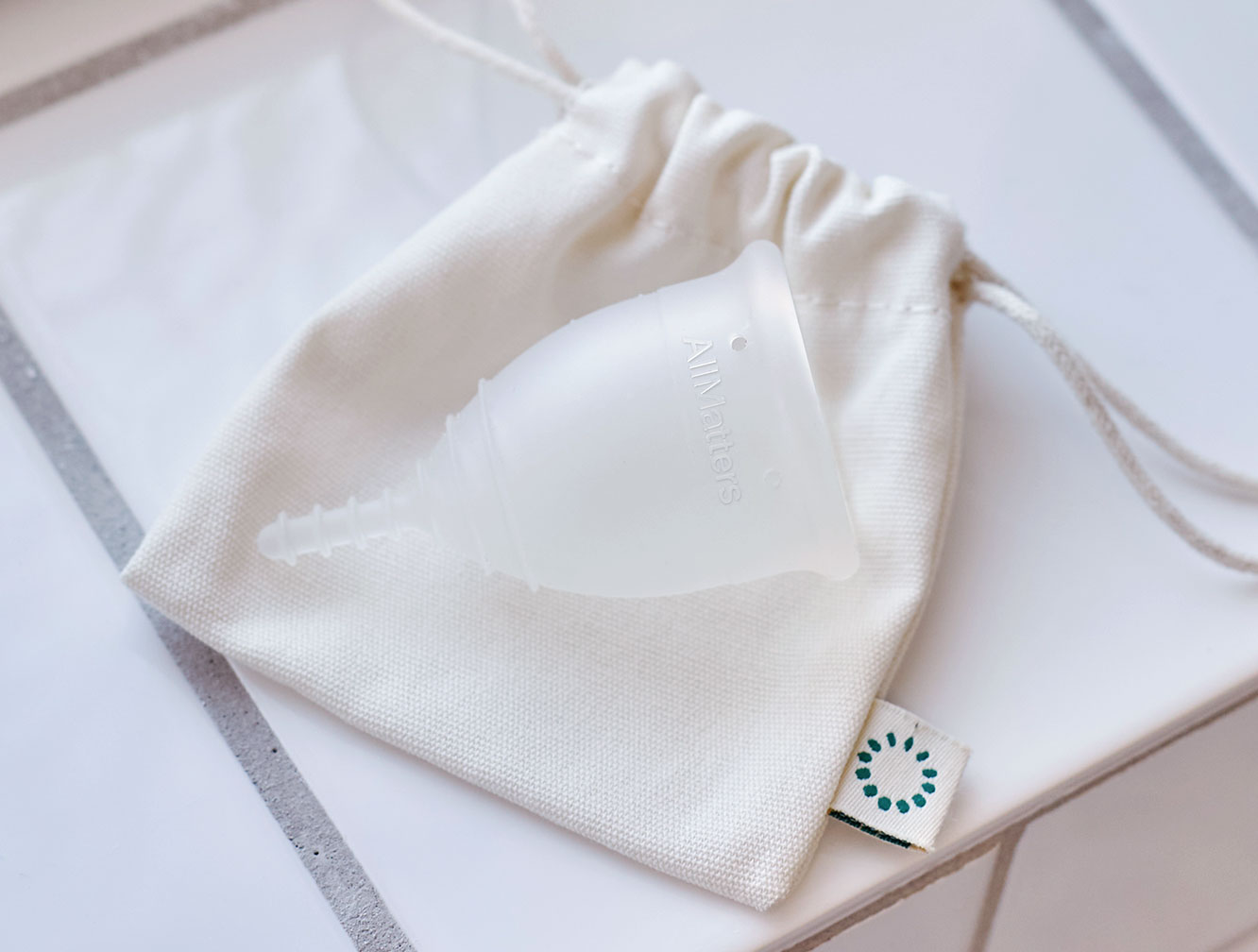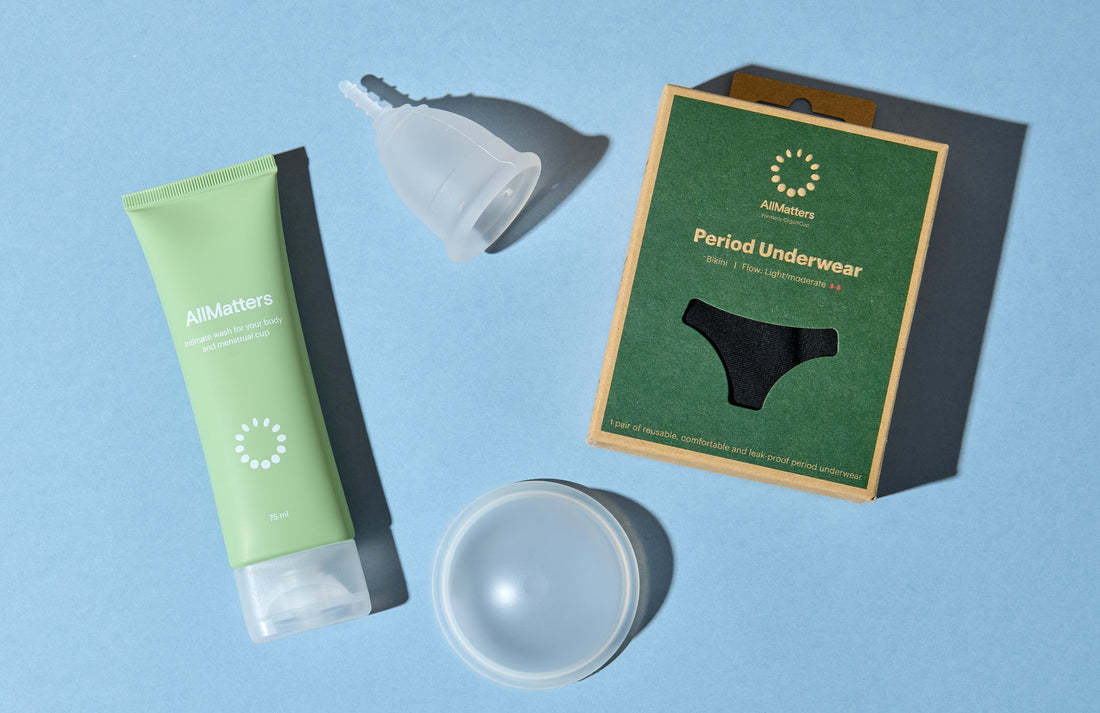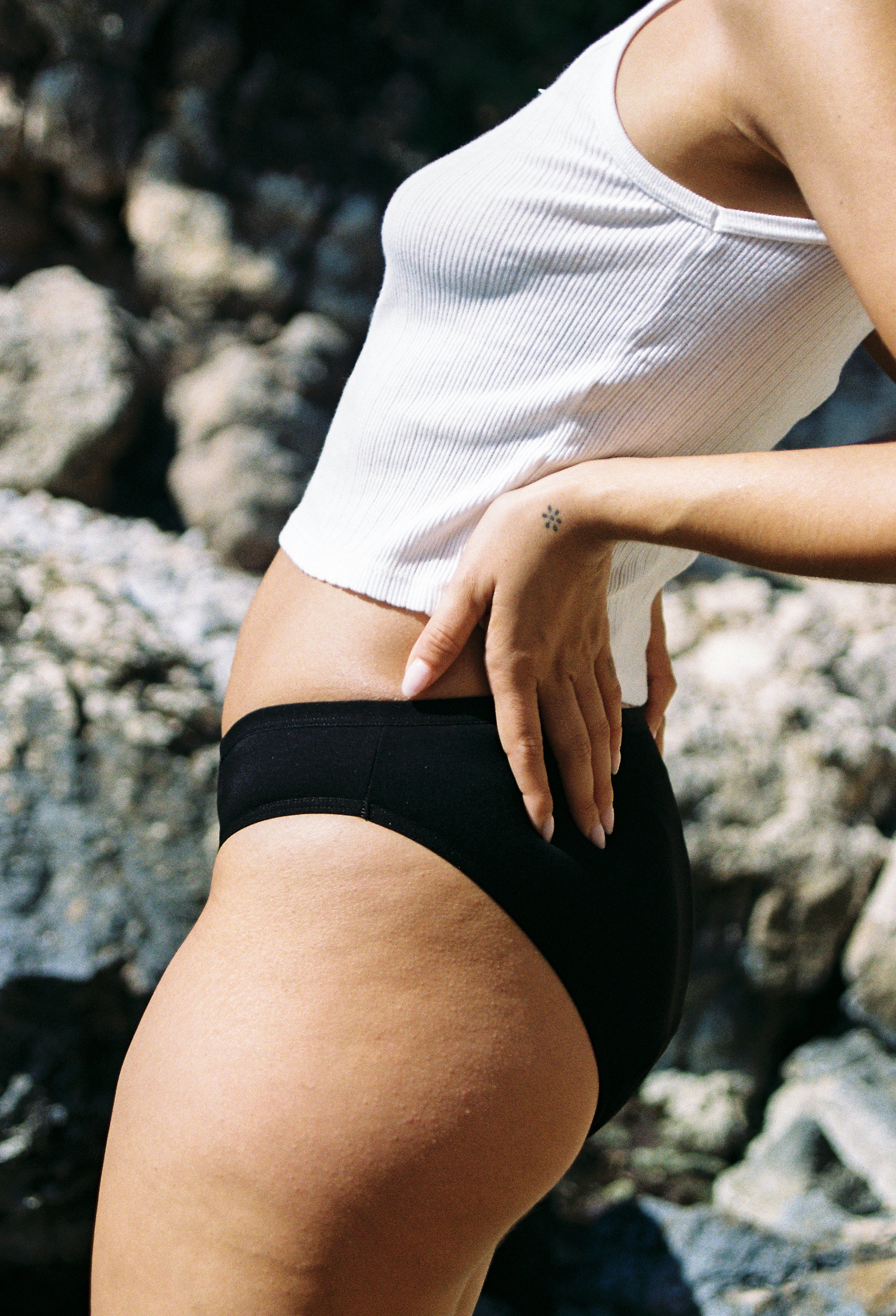You might be wondering things like, how does a menstrual cup work? What does it do? What if it has an odor? But don’t worry, we’ll answer all your questions in one of our biggest FAQs to date. Let’s start with the easy ones first.
What is a menstrual cup?
A menstrual cup is a sustainable and reusable period product. It is made from medical-grade silicone and is free from dyes, harmful chemicals and BPA. They are a flexible and easy-to-use alternative that can last for years. Instead of absorbing period blood like tampons or pads, menstrual cups collect the blood in their cone-shaped design. They come in multiple sizes, and ours are shipped with recycled cardboard to cut back on waste.
How much blood does a menstrual cup hold?
Well, good news, on average, menstrual cups hold more liquid and volume than other disposable menstrual products. Depending on the size of the menstrual cup, it can hold from 19ml up to a whopping 47ml of liquid. Now compare that to a tampon which on average only holds 5ml.
How to insert a menstrual cup
It can be a little challenging at first when inserting a cup, but there are a few things to remember.
- Always wash your hands with a mild soap or cup wash before touching yourself or your cup.
- Relax and get into a comfortable position
- Fold your cup in either a c fold or punch down fold
- Insert your cup and release it!
- It should never be uncomfortable or painful!
If you are a visual learner or would like a little more information, you can use our cup guide as a reference.
How to remove a menstrual cup
Once you’ve learned how to get it in, it’s time to learn how to get it out; and removing your menstrual cup properly is very important. Like insertion, it might take a few tries to get the hang of how to remove your cup quickly.
- Always wash your hands with a mild soap or cup wash before touching yourself or your cup.
- Relax and take a deep breath, and find a comfortable position that works best for you.
- Find the stem of the menstrual cup and make your way towards the base. Don’t pull on the stem.
- Pinch the bottom of the base to release the seal and gently ease the cup out.
- Empty, rinse and reinsert, or empty and sanitise
If you’re having trouble easing a finger to the rim of the cup, manually breaking the seal is an easy way to get your cup out.
What size menstrual cup should I use?
There are a few things to consider before choosing the size of your cup. If you are young, a virgin, or just have a small vaginal canal, you’ll probably want to go with a size mini to size A. If you have given birth before or have a heavy flow, you might be more comfortable with a size A to size B. Ultimately, sometimes a trial-and-error system is what works best. At AllMatters, we have a 90-day satisfaction guarantee, and if your cup doesn’t fit, we will exchange it for a new size for free.
How to clean a menstrual cup?
Cleaning your menstrual cup is easy; before and after each use, wash the cup with a mild soap or cup cleanser, turning over the cup to make sure the holes run clear. When you’re done with your period, simply boil your cup for 3-5 minutes, making sure it doesn’t touch the bottom of the pot. Once finished, you can store it in its cotton bag until your next cycle.
How long can you leave a menstrual cup in?
It all depends on your flow, but cups can be left in for up to 12 hours, and once it’s been washed, it’s good to be reinserted!
How will I know to empty my menstrual cup?
This depends on a lot of factors; how big your menstrual cup is, where you are in your cycle, how heavy your flow is, and how often you change your period products at the moment. It will take some time to get used to a menstrual cup, so we recommend changing your cup when you would usually change your pad or a tampon. Over time, you’ll see how full your cup is and can gauge from there. If you have a lot of room left in your cup, add a few hours to your next change. Over time, it will become as easy as changing a tampon.
How far up should a menstrual cup go?
Your menstrual cup should sit below your cervix, and because every body is different, some cervixes may sit higher or lower than others. On average, the stem should be about a half inch from your vaginal opening, but it could be higher up or lower, in which case, you might have to trim the stem.
When to replace a menstrual cup?
Menstrual cups are made to last for years, but there are some warning signs of when it has reached the end of its life. If you have any tears, cracks, or scratches on the cup, a foul odor, heavy staining, flaking, or a change in texture, it is time to replace your cup.
Can you have sex with a menstrual cup?
You can not have penetrative sex with a menstrual cup in, but you can have oral or anal sex with your cup in. It might readjust with vigorous movement or pressure, so be prepared in case of any leaks!
Can I swim or do other sports with a menstrual cup?
Yes, you can! You can use your menstrual cup during any physical activity, and it works just like traditional period products. Just be sure to check in and reinsert if you feel any movement from the cup during physical activity.
Can you sleep with a menstrual cup in?
Yep! It’s perfectly safe to sleep up to 12 hours with your menstrual cup in. If it’s your first time, we recommend wearing a pad just in case of any leaks.
What are the benefits of a menstrual cup?
There are many benefits to having a menstrual cup; they are safer, cheaper, and better for the environment. They can be worn with an IUD, tilted uterus, or other conditions when approved by a doctor. They last up for years and can be worn for up to 12 hours at a time, and they hold more liquid than both pads and tampons.
What are the risks of a menstrual cup?
Although the risks are fewer than traditional period products, it’s still good to be informed. Menstrual cups can leak, they can dislodge an IUD, cause infections if they’re not properly cared for, and still have a small risk of TSS – smaller than tampons. If you notice any pain or discomfort remove the cup and seek medical attention.
How much money do I save by using a cup?
By switching to a cup, studies have found that you spend 7% of what you would have spent on tampons and only 5% of what you would have on pads when swapping to a menstrual cup.
What to do if my cup is stained?
Always using cold water to rinse the cup before using warm water to wash the cup will help prevent staining. You can also give your cup a good scrub which will remove some surface stains. Sunlight can also help your menstrual cup; by leaving it in a sunny, but not hot, area for a few hours can reduce discoloration. Though, if you see a heavy discoloration on your cup, it might be time to order a replacement.
Can I use a menstrual cup if I’m a virgin?
Absolutely! Menstrual cups are for anyone with a period, and the menstrual cup should not disturb your hymen, break your hymen when properly inserted, or interfere with your virginity in any way. However, we do recommend our smallest size for virgins.
Are menstrual cups comfortable and safe?
When inserted properly, you should not be able to feel your menstrual cup at all! Menstrual cups have been proven to be even safer than tampons when it comes to TSS.
Are menstrual cups messy?
We won’t lie to you, and they can be messy, especially if you’re using them for the first time and if you are used to traditional products. Though, with all the benefits they give, they might justify the mess.






